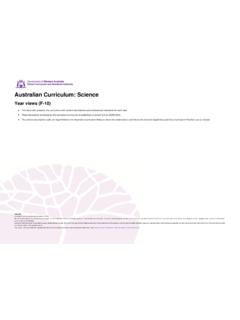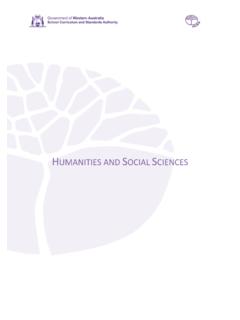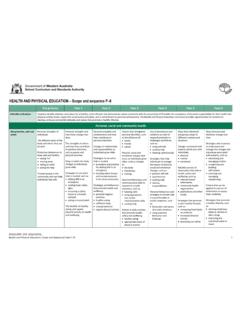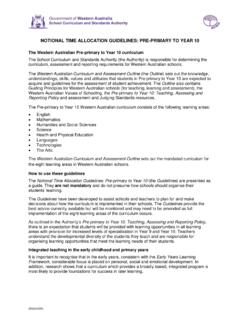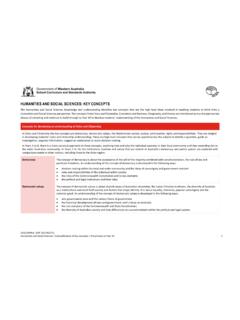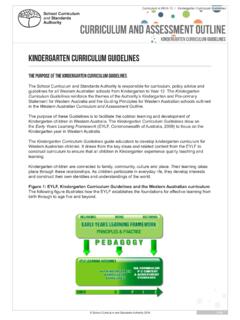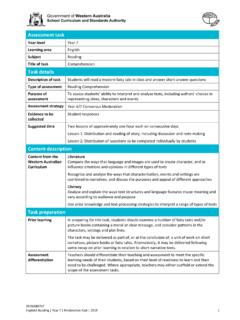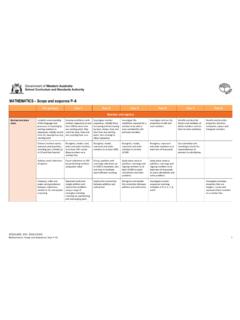Transcription of English Scope and Sequence: Foundation to Year 6
1 English Scope and sequence : Foundation to Year 6 Sub StrandFocus of thread within the sub-strandFoundation YearYear 1 Year 2 Year 3 Year 4 Year 5 Year 6 Language Variation and ChangeLanguage variation and changeHow English varies according to context and purpose including cultural and historical contextsUnderstand that English is one of many languages spoken in Australia and that different languages may be spoken by family, classmates and communityUnderstand that people use different systems of communication to cater to different needs and purposes and that many people may use sign systems to communicate with othersUnderstand that spoken, visual and written forms of language are different modes of communication with different features and their use varies according to the audience, purpose, context and cultural backgroundUnderstand that languages have different written and visual communication systems, different oral traditions and different ways of constructing meaningUnderstand that Standard Australian English is one of many social dialects used in Australia, and that while it originated in England it has been influenced by many other languagesUnderstand that the pronunciation.
2 Spelling and meanings of words have histories and change over timeUnderstand that different social and geographical dialects or accents are used in Australia in addition to Standard Australian English Language for interactionLanguage for social interactionsHow language used for different formal and informal social interactions is influenced by the purpose and audienceExplore how language is used differently at home and school depending on the relationships between peopleUnderstand that language is used in combination with other means of communication, for example facial expressions and gestures to interact with othersUnderstand that there are different ways of asking for information, making offers and giving commandsUnderstand that language varies when people take on different roles in social and classroom interactions and how the use of key interpersonal language resources varies depending on contextUnderstand that successful cooperation with others depends on shared use of social conventions, including turn-taking patterns, and forms of address that vary according to the degree of formality in social situationsUnderstand that social interactions influence the way people engage with ideas and respond to others for example when exploring and clarifying the ideas of others.
3 Summarising their own views and reporting them to a larger groupUnderstand that patterns of language interaction vary across social contexts and types of texts and that they help to signal social roles and relationshipsUnderstand that strategies for interaction become more complex and demanding as levels of formality and social distance increaseEvaluative languageHow language is used to express opinions, and make evaluative judgments about people, places, things and textsUnderstand that language can be used to explore ways of expressing needs, likes and dislikesExplore different ways of expressing emotions, including verbal, visual, body language and facial expressionsIdentify language that can be used for appreciating texts and the qualities of people and thingsExamine how evaluative language can be varied to be more or less forcefulUnderstand differences between the language of opinion and feeling and the language of factual reporting or recordingUnderstand how to move beyond making bare assertions and take account of differing perspectives and points of viewUnderstand the uses of objective and subjective language and biasText structure and organisationPurpose audience and structures of different types of textsHow texts serve different purposes and how the structures of types of texts vary according to the text purposeUnderstand that texts can take many forms, can be very short (for example an exit sign)
4 Or quite long (for example an information book or a film) and that stories and informative texts have different purposesUnderstand that the purposes texts serve shape their structure in predictable waysUnderstand that different types of texts have identifiable text structures and language features that help the text serve its purposeUnderstand how different types of texts vary in use of language choices, depending on their purpose and context (for example, tense and types of sentences)Understand how texts vary in complexity and technicality depending on the approach to the topic, the purpose and the intended audienceUnderstand how texts vary in purpose, structure and topic as well as the degree of formalityUnderstand how authors often innovate on text structures and play with language features to achieve particular aesthetic, humorous and persuasive purposes and effectsText cohesionHow texts work as cohesive wholes through language features which link the parts of the text together, such as paragraphs, connectives, nouns and associated pronounsUnderstand that some language in written texts is unlike everyday spoken languageUnderstand patterns of repetition and contrast in simple textsUnderstand how texts are made cohesive through resources, for example word associations, synonyms.
5 And antonyms Understand that paragraphs are a key organisational feature of written textsUnderstand how texts are made cohesive through the use of linking devices including pronoun reference and text connectivesUnderstand that the starting point of a sentence gives prominence to the message in the text and allows for prediction of how the text will unfoldUnderstand that cohesive links can be made in texts by omitting or replacing wordsPunctuationHow punctuation works to perform different functions in a that punctuation is a feature of written text different from letters; recognise how capital letters are used for names, and that capital letters and full stops signal the beginning and end of sentencesRecognise that different types of punctuation, including full stops, question marks and exclamation marks, signal sentences that make statements, ask questions, express emotion or give commandsRecognise that capital letters signal proper nouns and commas are used to separate items in listsKnow that word contractions are a feature of informal language and that apostrophes of contraction are used to signal missing lettersRecognise how quotation marks are used in texts to signal dialogue, titles and quoted (direct)
6 SpeechUnderstand how the grammatical category of possessives is signalled through apostrophes and how to use apostrophes with common and proper nounsUnderstand the uses of commas to separate clausesConcepts of print and screenThe different conventions that apply to how text is presented on a page or screenUnderstand concepts about print and screen, including how books, film and simple digital texts work, and know some features of print, for example directionalityUnderstand concepts about print and screen, including how different types of texts are organised using page numbering, tables of content, headings and titles, navigation buttons, bars and linksKnow some features of text organisation including page and screen layouts, alphabetical order, and different types of diagrams, for example timelinesIdentify the features of online texts that enhance navigationIdentify features of online texts that enhance readability including text, navigation, links, graphics and layoutInvestigate how the organisation of texts into chapters, headings, subheadings.
7 Home pages and sub pages for online texts and according to chronology or topic can be used to predict content and assist navigationThis sequence ends at Year 5 Version January 2012 Sub StrandFocus of thread within the sub-strandYear 6 Year 7 Year 8 Year 9 Year 10 Language Variation and ChangeLanguage variation and changeHow English varies according to context and purpose including cultural and historical contextsUnderstand that different social and geographical dialects or accents are used in Australia in addition to Standard Australian English Understand the way language evolves to reflect a changing world, particularly in response to the use of new technology for presenting texts and communicatingUnderstand the influence and impact that the English language has had on other languages or dialects and how English has been influenced in returnUnderstand that Standard Australian English is a living language within which the creation and loss of words and the evolution of usage is ongoingUnderstand that Standard Australian English in its spoken and written forms has a history of evolution and change and continues to evolveLanguage for interactionLanguage for social interactionsHow language used for different formal and informal social interactions is influenced by the purpose and audienceUnderstand that strategies for interaction become more complex and demanding as levels of formality and social distance
8 IncreaseUnderstand how accents, styles of speech and idioms express and create personal and social identitiesUnderstand how conventions of speech adopted by communities influence the identities of people in those communitiesUnderstand that roles and relationships are developed and challenged through language and interpersonal skills Understand how language use can have inclusive and exclusive social effects, and can empower or disempower peopleEvaluative languageHow language is used to express opinions, and make evaluative judgments about people, places, things and textsUnderstand the uses of objective and subjective language and biasUnderstand how language is used to evaluate texts and how evaluations about a text can be substantiated by reference to the text and other sourcesUnderstand how rhetorical devices are used to persuade and how different layers of meaning are developed through the use of metaphor, irony and parody Investigate how evaluation can be expressed directly and indirectly using devices, for example allusion, evocative vocabulary and metaphorUnderstand that people s evaluations of texts are influenced by their value systems.
9 The context and the purpose and mode of communicationText structure and organisationPurpose audience and structures of different types of textsHow texts serve different purposes and how the structures of types of texts vary according to the text purposeUnderstand how authors often innovate on text structures and play with language features to achieve particular aesthetic, humorous and persuasive purposes and effectsUnderstand and explain how the text structures and language features of texts become more complex in informative and persuasive texts and identify underlying structures such as taxonomies, cause and effect, and extended metaphorsAnalyse how the text structures and language features of persuasive texts, including media texts, vary according to the medium and mode of communicationUnderstand that authors innovate with text structures and language for specific purposes and effectsCompare the purposes, text structures and language features of traditional and contemporary texts in different mediaText cohesionHow texts work as cohesive wholes through language features which link the parts of the text together, such as paragraphs, connectives, nouns and associated pronounsUnderstand that cohesive links can be made in texts by omitting or replacing wordsUnderstand that the coherence of more complex texts relies on devices that signal text structure and guide readers, for example overviews, initial and concluding paragraphs and topic sentences.
10 Indexes or site maps or breadcrumb trails for online textsUnderstand how cohesion in texts is improved by strengthening the internal structure of paragraphs through the use of examples, quotations and substantiation of claimsUnderstand how coherence is created in complex texts through devices like lexical cohesion, ellipsis, grammatical theme and text connectivesCompare and contrast the use of cohesive devices in texts, focusing on how they serve to signpost ideas, to make connections and to build semantic associations between ideas Understand how paragraphs and images can be arranged for different purposes, audiences, perspectives and stylistic effects PunctuationHow punctuation works to perform different functions in a the uses of commas to separate clausesUnderstand the use of punctuation to support meaning in complex sentences with phra
